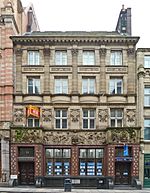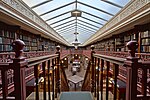Mill Hill Chapel
18th-century Protestant churchesChurches completed in 1848Churches in LeedsGrade II* listed churches in West YorkshireLeeds Blue Plaques ... and 3 more
Listed buildings in LeedsUnitarian chapels in EnglandUse British English from November 2018

Mill Hill Chapel is a Unitarian church in Leeds, West Yorkshire, England. It is a member of the General Assembly of Unitarian and Free Christian Churches, the umbrella organisation for British Unitarians. The building, which stands in the centre of the city on City Square, was granted Grade II* listed status in 1963.
Excerpt from the Wikipedia article Mill Hill Chapel (License: CC BY-SA 3.0, Authors, Images).Mill Hill Chapel
Lower Basinghall Street, Leeds Holbeck Urban Village
Geographical coordinates (GPS) Address External links Nearby Places Show on map
Geographical coordinates (GPS)
| Latitude | Longitude |
|---|---|
| N 53.7967 ° | E -1.5466 ° |
Address
Mill Hill Unitarian Chapel
Lower Basinghall Street
LS1 5EB Leeds, Holbeck Urban Village
England, United Kingdom
Open on Google Maps











